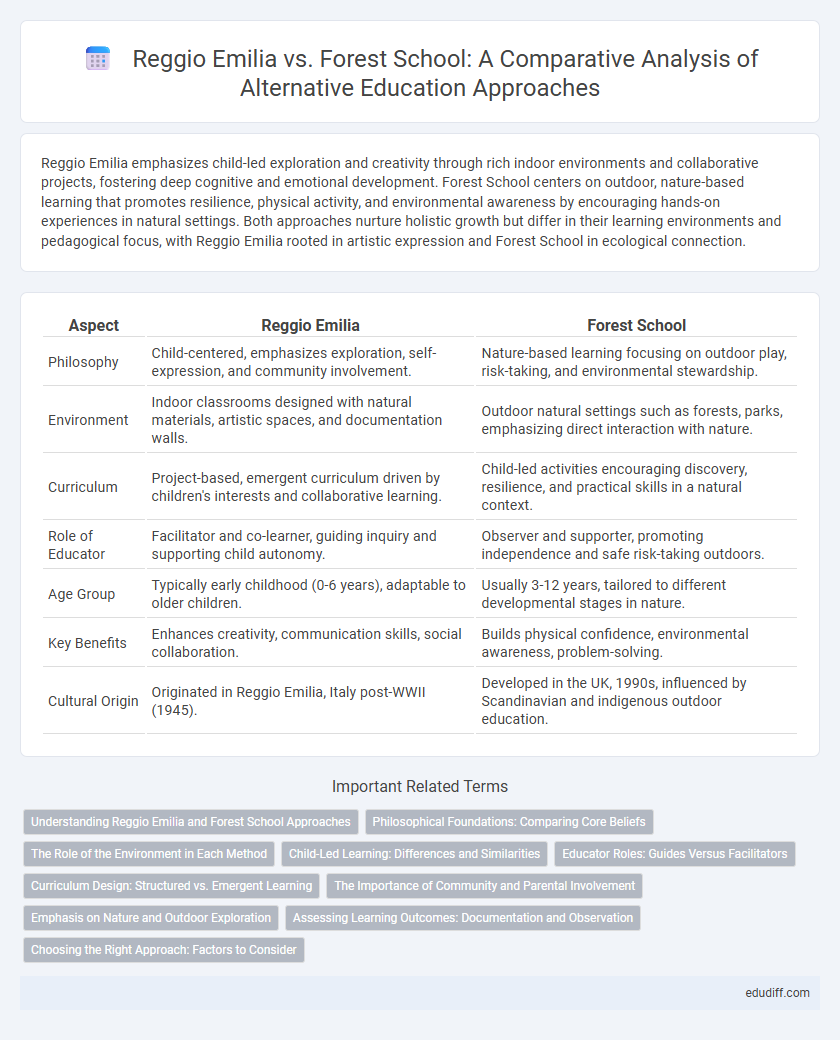Reggio Emilia emphasizes child-led exploration and creativity through rich indoor environments and collaborative projects, fostering deep cognitive and emotional development. Forest School centers on outdoor, nature-based learning that promotes resilience, physical activity, and environmental awareness by encouraging hands-on experiences in natural settings. Both approaches nurture holistic growth but differ in their learning environments and pedagogical focus, with Reggio Emilia rooted in artistic expression and Forest School in ecological connection.
Table of Comparison
| Aspect | Reggio Emilia | Forest School |
|---|---|---|
| Philosophy | Child-centered, emphasizes exploration, self-expression, and community involvement. | Nature-based learning focusing on outdoor play, risk-taking, and environmental stewardship. |
| Environment | Indoor classrooms designed with natural materials, artistic spaces, and documentation walls. | Outdoor natural settings such as forests, parks, emphasizing direct interaction with nature. |
| Curriculum | Project-based, emergent curriculum driven by children's interests and collaborative learning. | Child-led activities encouraging discovery, resilience, and practical skills in a natural context. |
| Role of Educator | Facilitator and co-learner, guiding inquiry and supporting child autonomy. | Observer and supporter, promoting independence and safe risk-taking outdoors. |
| Age Group | Typically early childhood (0-6 years), adaptable to older children. | Usually 3-12 years, tailored to different developmental stages in nature. |
| Key Benefits | Enhances creativity, communication skills, social collaboration. | Builds physical confidence, environmental awareness, problem-solving. |
| Cultural Origin | Originated in Reggio Emilia, Italy post-WWII (1945). | Developed in the UK, 1990s, influenced by Scandinavian and indigenous outdoor education. |
Understanding Reggio Emilia and Forest School Approaches
The Reggio Emilia approach emphasizes child-led exploration, creativity, and a rich, prepared environment fostering collaborative learning, rooted in respect for the child's capabilities. Forest School focuses on outdoor, experiential education promoting resilience, independence, and a deep connection with nature through regular, hands-on woodland activities. Both methods prioritize holistic development but differ in setting and pedagogical focus, with Reggio Emilia often implemented indoors and Forest School relying on natural environments for learning.
Philosophical Foundations: Comparing Core Beliefs
Reggio Emilia embraces a constructivist philosophy emphasizing child-led exploration, collaboration, and the environment as the third teacher, fostering creativity and critical thinking. Forest School centers on experiential learning through nature, promoting resilience, independence, and emotional wellbeing via self-directed outdoor activities. Both approaches prioritize learner autonomy and holistic development but differ in setting and interaction with the environment as foundational elements.
The Role of the Environment in Each Method
Reggio Emilia emphasizes a carefully designed, aesthetically rich environment that acts as the "third teacher," encouraging exploration, creativity, and collaboration through natural materials and flexible spaces. Forest School prioritizes outdoor, nature-based settings where the environment fosters resilience, risk-taking, and hands-on learning by engaging children directly with natural elements and seasonal changes. Both methods view the environment as essential but diverge in their emphasis on indoor artistic spaces versus immersive outdoor experiences.
Child-Led Learning: Differences and Similarities
Reggio Emilia and Forest School both emphasize child-led learning, allowing children to explore their interests and environment autonomously. Reggio Emilia focuses on collaborative projects and expressive arts, fostering communication and creativity through the "Hundred Languages of Children," while Forest School prioritizes outdoor experiential learning that builds physical confidence and resilience. Both approaches value observation and reflection by educators to tailor experiences, promoting holistic development and self-directed discovery.
Educator Roles: Guides Versus Facilitators
Reggio Emilia educators act as skilled guides, carefully observing and documenting children's experiences to inspire deeper inquiry and creativity. Forest School facilitators create open-ended, nature-based environments, encouraging learners to explore and problem-solve independently. Both roles emphasize child-centered learning but differ in their level of direct guidance and interaction within the educational process.
Curriculum Design: Structured vs. Emergent Learning
Reggio Emilia emphasizes a structured curriculum design centered on intentional projects and a rich environment that fosters deep exploration, while Forest School prioritizes emergent learning through child-led experiences in natural settings. Reggio Emilia's approach integrates collaborative documentation and thematic planning, allowing educators to scaffold knowledge systematically. In contrast, Forest School's curriculum adapts dynamically to learners' interests, promoting resilience and problem-solving through unstructured outdoor activities.
The Importance of Community and Parental Involvement
Reggio Emilia emphasizes strong parental involvement by treating parents as partners in the educational process, fostering a collaborative community that supports children's learning and development. Forest School prioritizes community engagement through outdoor, nature-based experiences that encourage group cooperation, social skills, and shared responsibility. Both approaches recognize that active community participation and parental support are crucial for holistic child development and creating enriching learning environments.
Emphasis on Nature and Outdoor Exploration
Reggio Emilia and Forest School both prioritize nature and outdoor exploration but differ in approach; Reggio Emilia integrates natural elements as part of a broader environment encouraging sensory experiences and creativity, while Forest School centers entirely on immersive, child-led learning in natural settings. Reggio Emilia classrooms often feature natural materials and outdoor classrooms designed to stimulate curiosity and environmental awareness. Forest School programs emphasize regular, sustained outdoor sessions where children develop resilience, problem-solving, and environmental stewardship through direct interaction with forests and natural landscapes.
Assessing Learning Outcomes: Documentation and Observation
Reggio Emilia approaches assessment through detailed documentation and observation, capturing children's learning processes via portfolios, photographs, and teacher reflections to make learning visible and support individualized development. Forest School emphasizes naturalistic observation and anecdotal records, focusing on children's social, emotional, and physical growth within outdoor, experiential settings. Both frameworks prioritize formative, qualitative assessments over standardized testing to foster holistic and child-centered learning outcomes.
Choosing the Right Approach: Factors to Consider
Reggio Emilia emphasizes child-led exploration and creative expression within a structured environment, while Forest School prioritizes outdoor, experiential learning and nature connection. Parents should consider factors such as their child's temperament, learning style, and family values related to nature and social interaction. Accessibility, educator expertise, and curriculum flexibility also play crucial roles in choosing the most suitable alternative education approach.
Reggio Emilia vs Forest School Infographic

 edudiff.com
edudiff.com